University Assignment: Innovative Thinking and Employee Development
VerifiedAdded on 2022/08/24
|7
|1886
|17
Report
AI Summary
This report delves into the crucial aspects of innovative thinking and employee development within organizations. It explores the creative process, highlighting the importance of both exploratory and critical thinking, as well as the stages involved, including information gathering, incubation, illumination, integration, and illustration. The report emphasizes the role of leadership in cultivating a creative environment, citing examples from companies like Visa and Google. It also discusses techniques such as brainstorming and the use of "what if" scenarios to encourage employee participation and idea generation. Furthermore, the report underscores the significance of critical feedback, inclusivity, and data-driven decision-making in fostering innovation. Ultimately, the report concludes that a combination of attitude, technique, and skill is essential for organizations to promote a creative and innovative culture, leading to enhanced employee engagement and competitive advantage.
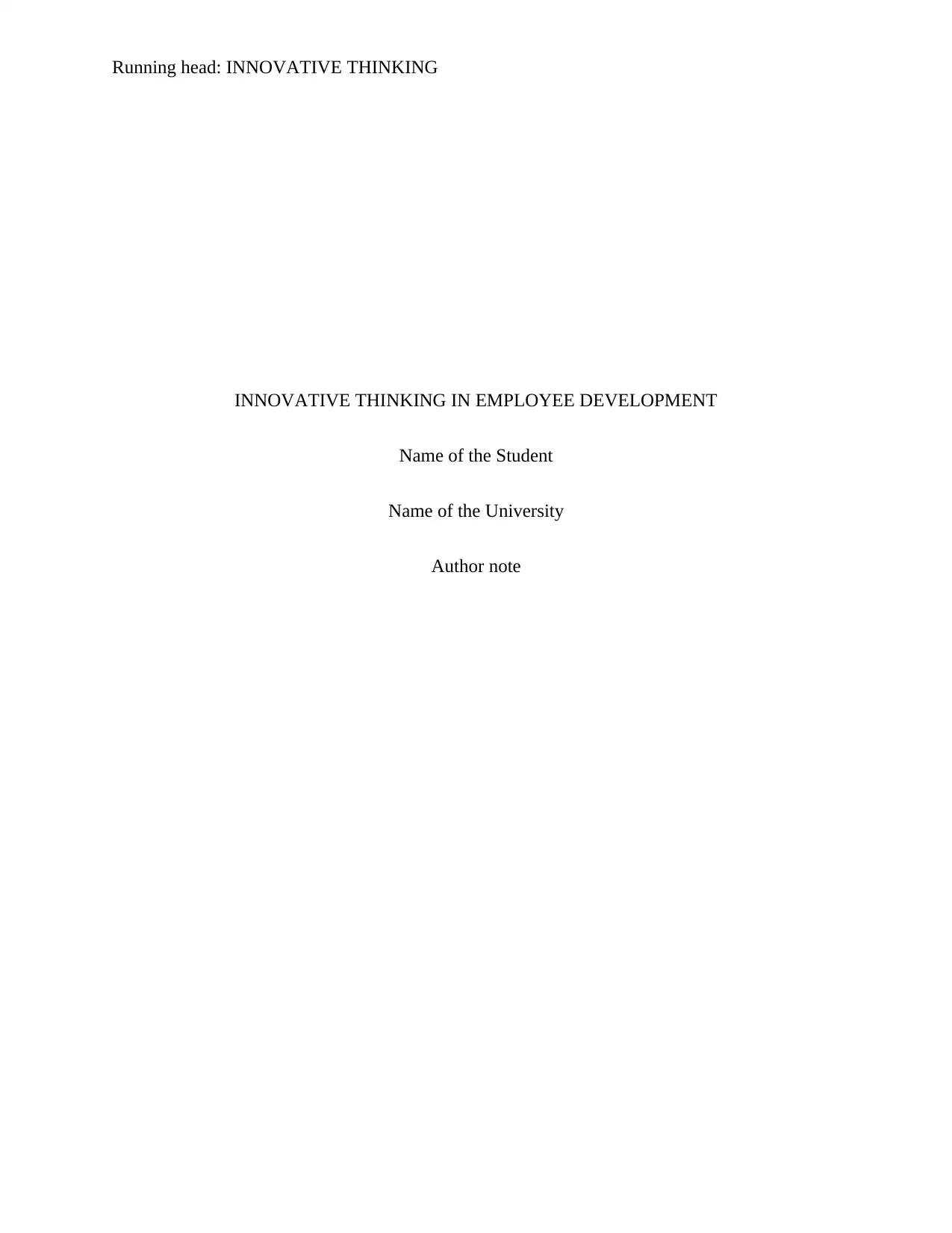
Running head: INNOVATIVE THINKING
INNOVATIVE THINKING IN EMPLOYEE DEVELOPMENT
Name of the Student
Name of the University
Author note
INNOVATIVE THINKING IN EMPLOYEE DEVELOPMENT
Name of the Student
Name of the University
Author note
Paraphrase This Document
Need a fresh take? Get an instant paraphrase of this document with our AI Paraphraser
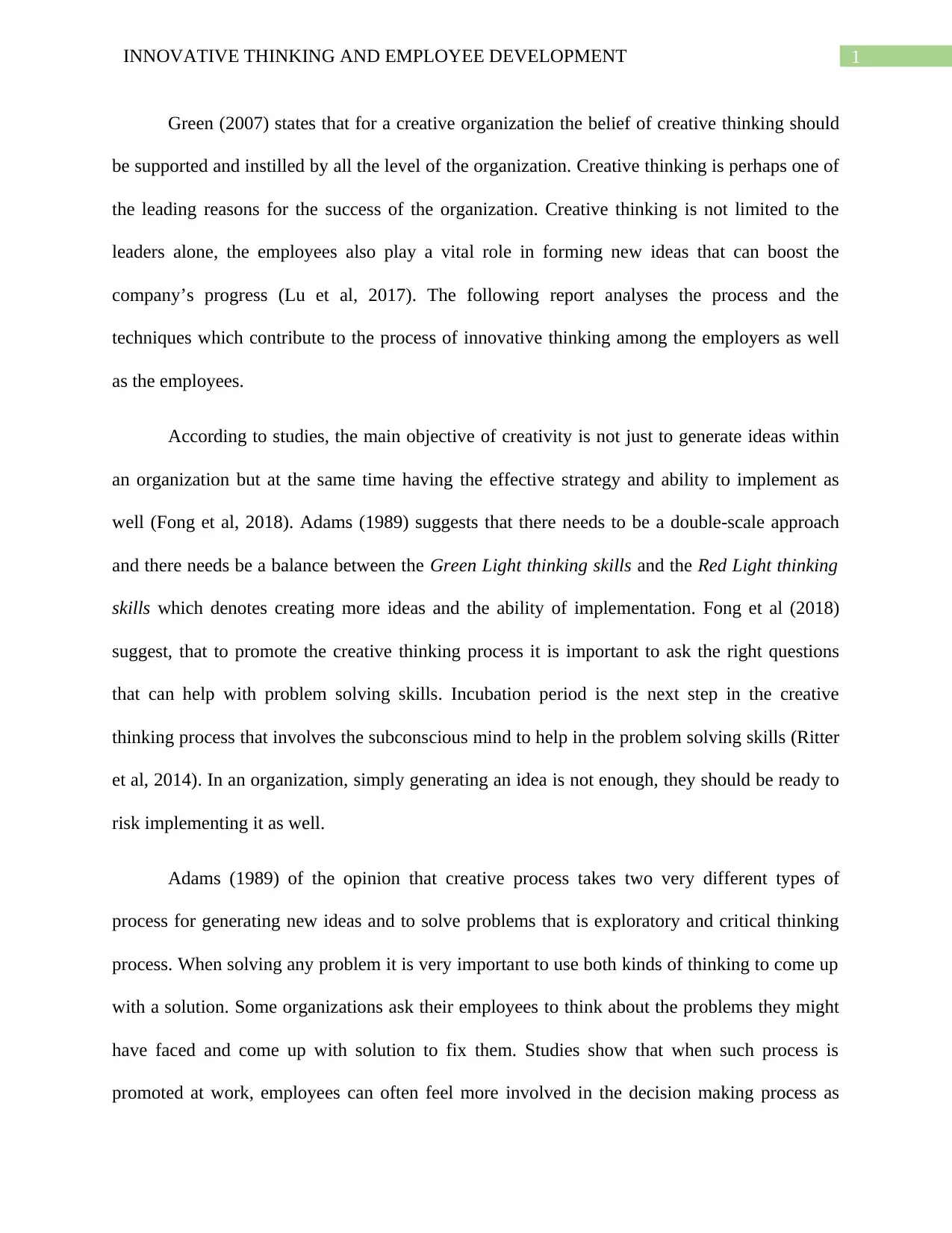
1INNOVATIVE THINKING AND EMPLOYEE DEVELOPMENT
Green (2007) states that for a creative organization the belief of creative thinking should
be supported and instilled by all the level of the organization. Creative thinking is perhaps one of
the leading reasons for the success of the organization. Creative thinking is not limited to the
leaders alone, the employees also play a vital role in forming new ideas that can boost the
company’s progress (Lu et al, 2017). The following report analyses the process and the
techniques which contribute to the process of innovative thinking among the employers as well
as the employees.
According to studies, the main objective of creativity is not just to generate ideas within
an organization but at the same time having the effective strategy and ability to implement as
well (Fong et al, 2018). Adams (1989) suggests that there needs to be a double-scale approach
and there needs be a balance between the Green Light thinking skills and the Red Light thinking
skills which denotes creating more ideas and the ability of implementation. Fong et al (2018)
suggest, that to promote the creative thinking process it is important to ask the right questions
that can help with problem solving skills. Incubation period is the next step in the creative
thinking process that involves the subconscious mind to help in the problem solving skills (Ritter
et al, 2014). In an organization, simply generating an idea is not enough, they should be ready to
risk implementing it as well.
Adams (1989) of the opinion that creative process takes two very different types of
process for generating new ideas and to solve problems that is exploratory and critical thinking
process. When solving any problem it is very important to use both kinds of thinking to come up
with a solution. Some organizations ask their employees to think about the problems they might
have faced and come up with solution to fix them. Studies show that when such process is
promoted at work, employees can often feel more involved in the decision making process as
Green (2007) states that for a creative organization the belief of creative thinking should
be supported and instilled by all the level of the organization. Creative thinking is perhaps one of
the leading reasons for the success of the organization. Creative thinking is not limited to the
leaders alone, the employees also play a vital role in forming new ideas that can boost the
company’s progress (Lu et al, 2017). The following report analyses the process and the
techniques which contribute to the process of innovative thinking among the employers as well
as the employees.
According to studies, the main objective of creativity is not just to generate ideas within
an organization but at the same time having the effective strategy and ability to implement as
well (Fong et al, 2018). Adams (1989) suggests that there needs to be a double-scale approach
and there needs be a balance between the Green Light thinking skills and the Red Light thinking
skills which denotes creating more ideas and the ability of implementation. Fong et al (2018)
suggest, that to promote the creative thinking process it is important to ask the right questions
that can help with problem solving skills. Incubation period is the next step in the creative
thinking process that involves the subconscious mind to help in the problem solving skills (Ritter
et al, 2014). In an organization, simply generating an idea is not enough, they should be ready to
risk implementing it as well.
Adams (1989) of the opinion that creative process takes two very different types of
process for generating new ideas and to solve problems that is exploratory and critical thinking
process. When solving any problem it is very important to use both kinds of thinking to come up
with a solution. Some organizations ask their employees to think about the problems they might
have faced and come up with solution to fix them. Studies show that when such process is
promoted at work, employees can often feel more involved in the decision making process as
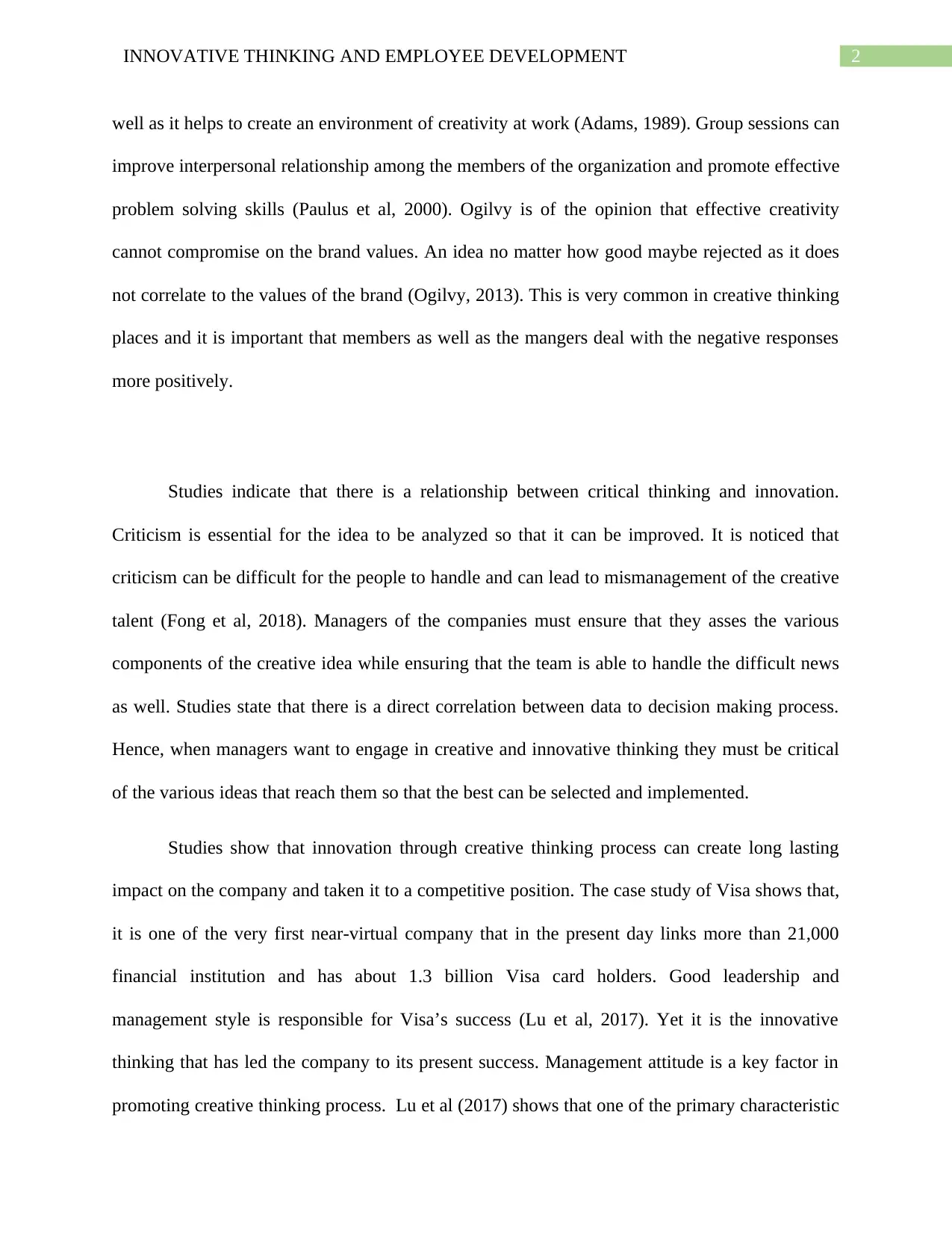
2INNOVATIVE THINKING AND EMPLOYEE DEVELOPMENT
well as it helps to create an environment of creativity at work (Adams, 1989). Group sessions can
improve interpersonal relationship among the members of the organization and promote effective
problem solving skills (Paulus et al, 2000). Ogilvy is of the opinion that effective creativity
cannot compromise on the brand values. An idea no matter how good maybe rejected as it does
not correlate to the values of the brand (Ogilvy, 2013). This is very common in creative thinking
places and it is important that members as well as the mangers deal with the negative responses
more positively.
Studies indicate that there is a relationship between critical thinking and innovation.
Criticism is essential for the idea to be analyzed so that it can be improved. It is noticed that
criticism can be difficult for the people to handle and can lead to mismanagement of the creative
talent (Fong et al, 2018). Managers of the companies must ensure that they asses the various
components of the creative idea while ensuring that the team is able to handle the difficult news
as well. Studies state that there is a direct correlation between data to decision making process.
Hence, when managers want to engage in creative and innovative thinking they must be critical
of the various ideas that reach them so that the best can be selected and implemented.
Studies show that innovation through creative thinking process can create long lasting
impact on the company and taken it to a competitive position. The case study of Visa shows that,
it is one of the very first near-virtual company that in the present day links more than 21,000
financial institution and has about 1.3 billion Visa card holders. Good leadership and
management style is responsible for Visa’s success (Lu et al, 2017). Yet it is the innovative
thinking that has led the company to its present success. Management attitude is a key factor in
promoting creative thinking process. Lu et al (2017) shows that one of the primary characteristic
well as it helps to create an environment of creativity at work (Adams, 1989). Group sessions can
improve interpersonal relationship among the members of the organization and promote effective
problem solving skills (Paulus et al, 2000). Ogilvy is of the opinion that effective creativity
cannot compromise on the brand values. An idea no matter how good maybe rejected as it does
not correlate to the values of the brand (Ogilvy, 2013). This is very common in creative thinking
places and it is important that members as well as the mangers deal with the negative responses
more positively.
Studies indicate that there is a relationship between critical thinking and innovation.
Criticism is essential for the idea to be analyzed so that it can be improved. It is noticed that
criticism can be difficult for the people to handle and can lead to mismanagement of the creative
talent (Fong et al, 2018). Managers of the companies must ensure that they asses the various
components of the creative idea while ensuring that the team is able to handle the difficult news
as well. Studies state that there is a direct correlation between data to decision making process.
Hence, when managers want to engage in creative and innovative thinking they must be critical
of the various ideas that reach them so that the best can be selected and implemented.
Studies show that innovation through creative thinking process can create long lasting
impact on the company and taken it to a competitive position. The case study of Visa shows that,
it is one of the very first near-virtual company that in the present day links more than 21,000
financial institution and has about 1.3 billion Visa card holders. Good leadership and
management style is responsible for Visa’s success (Lu et al, 2017). Yet it is the innovative
thinking that has led the company to its present success. Management attitude is a key factor in
promoting creative thinking process. Lu et al (2017) shows that one of the primary characteristic
⊘ This is a preview!⊘
Do you want full access?
Subscribe today to unlock all pages.

Trusted by 1+ million students worldwide
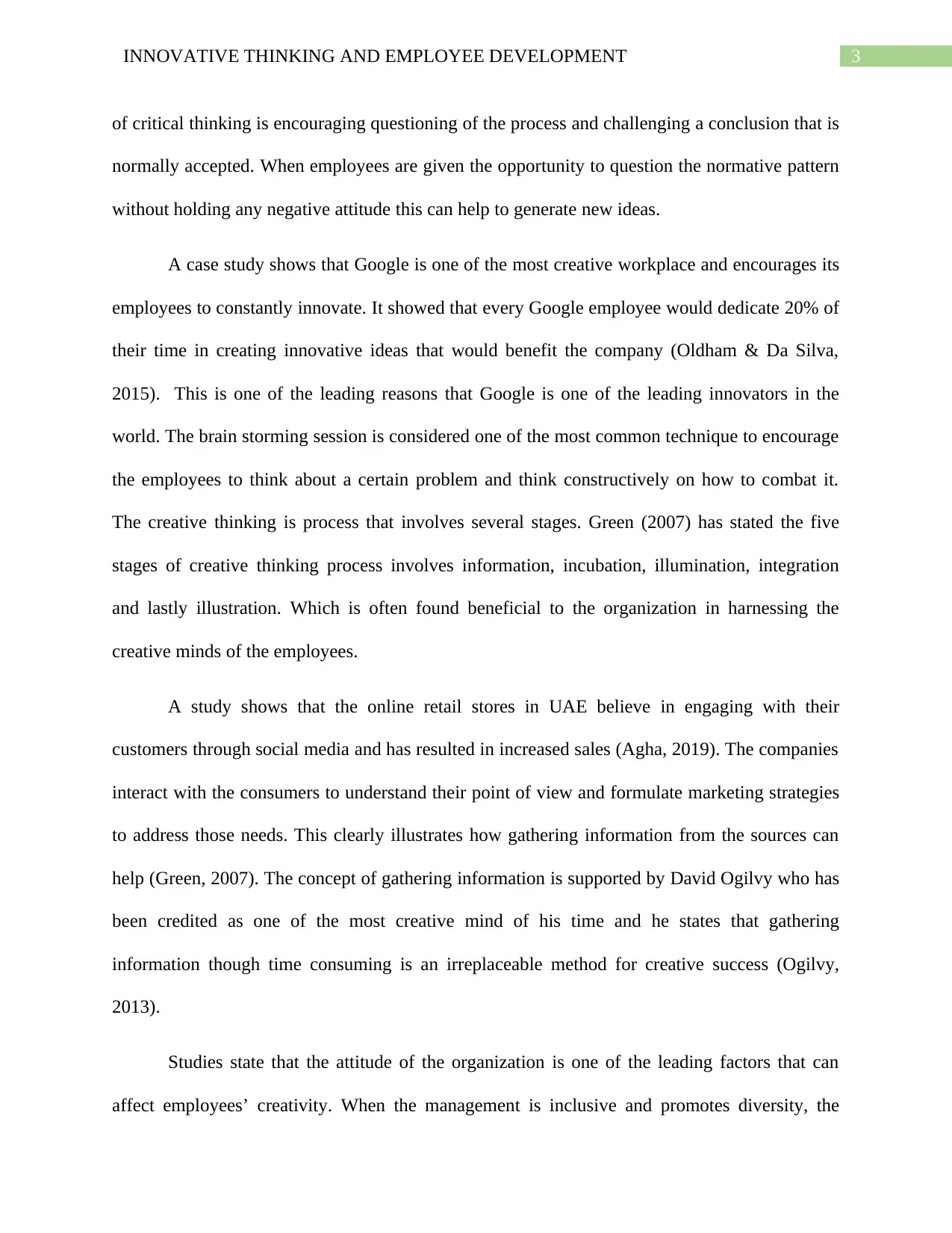
3INNOVATIVE THINKING AND EMPLOYEE DEVELOPMENT
of critical thinking is encouraging questioning of the process and challenging a conclusion that is
normally accepted. When employees are given the opportunity to question the normative pattern
without holding any negative attitude this can help to generate new ideas.
A case study shows that Google is one of the most creative workplace and encourages its
employees to constantly innovate. It showed that every Google employee would dedicate 20% of
their time in creating innovative ideas that would benefit the company (Oldham & Da Silva,
2015). This is one of the leading reasons that Google is one of the leading innovators in the
world. The brain storming session is considered one of the most common technique to encourage
the employees to think about a certain problem and think constructively on how to combat it.
The creative thinking is process that involves several stages. Green (2007) has stated the five
stages of creative thinking process involves information, incubation, illumination, integration
and lastly illustration. Which is often found beneficial to the organization in harnessing the
creative minds of the employees.
A study shows that the online retail stores in UAE believe in engaging with their
customers through social media and has resulted in increased sales (Agha, 2019). The companies
interact with the consumers to understand their point of view and formulate marketing strategies
to address those needs. This clearly illustrates how gathering information from the sources can
help (Green, 2007). The concept of gathering information is supported by David Ogilvy who has
been credited as one of the most creative mind of his time and he states that gathering
information though time consuming is an irreplaceable method for creative success (Ogilvy,
2013).
Studies state that the attitude of the organization is one of the leading factors that can
affect employees’ creativity. When the management is inclusive and promotes diversity, the
of critical thinking is encouraging questioning of the process and challenging a conclusion that is
normally accepted. When employees are given the opportunity to question the normative pattern
without holding any negative attitude this can help to generate new ideas.
A case study shows that Google is one of the most creative workplace and encourages its
employees to constantly innovate. It showed that every Google employee would dedicate 20% of
their time in creating innovative ideas that would benefit the company (Oldham & Da Silva,
2015). This is one of the leading reasons that Google is one of the leading innovators in the
world. The brain storming session is considered one of the most common technique to encourage
the employees to think about a certain problem and think constructively on how to combat it.
The creative thinking is process that involves several stages. Green (2007) has stated the five
stages of creative thinking process involves information, incubation, illumination, integration
and lastly illustration. Which is often found beneficial to the organization in harnessing the
creative minds of the employees.
A study shows that the online retail stores in UAE believe in engaging with their
customers through social media and has resulted in increased sales (Agha, 2019). The companies
interact with the consumers to understand their point of view and formulate marketing strategies
to address those needs. This clearly illustrates how gathering information from the sources can
help (Green, 2007). The concept of gathering information is supported by David Ogilvy who has
been credited as one of the most creative mind of his time and he states that gathering
information though time consuming is an irreplaceable method for creative success (Ogilvy,
2013).
Studies state that the attitude of the organization is one of the leading factors that can
affect employees’ creativity. When the management is inclusive and promotes diversity, the
Paraphrase This Document
Need a fresh take? Get an instant paraphrase of this document with our AI Paraphraser
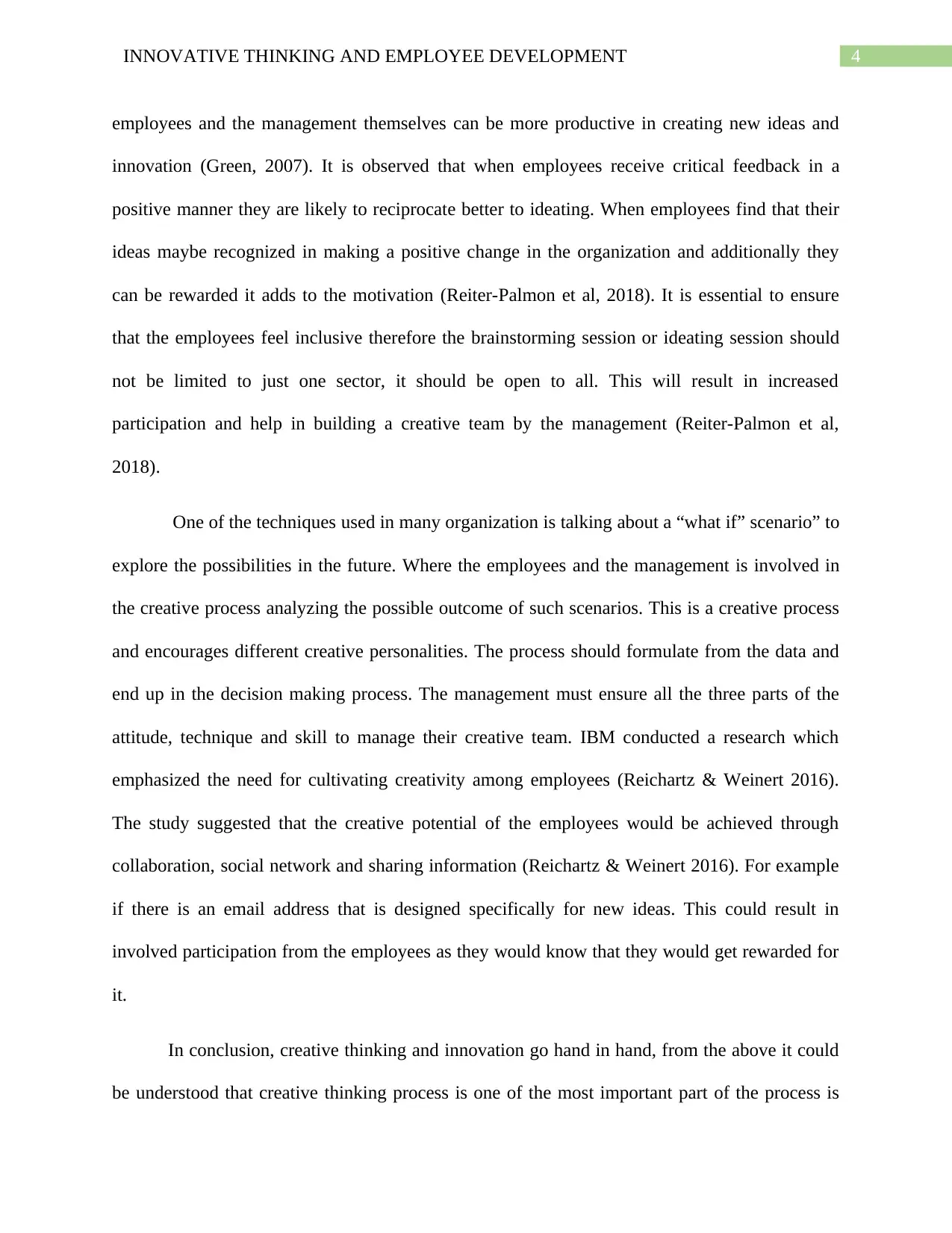
4INNOVATIVE THINKING AND EMPLOYEE DEVELOPMENT
employees and the management themselves can be more productive in creating new ideas and
innovation (Green, 2007). It is observed that when employees receive critical feedback in a
positive manner they are likely to reciprocate better to ideating. When employees find that their
ideas maybe recognized in making a positive change in the organization and additionally they
can be rewarded it adds to the motivation (Reiter-Palmon et al, 2018). It is essential to ensure
that the employees feel inclusive therefore the brainstorming session or ideating session should
not be limited to just one sector, it should be open to all. This will result in increased
participation and help in building a creative team by the management (Reiter-Palmon et al,
2018).
One of the techniques used in many organization is talking about a “what if” scenario” to
explore the possibilities in the future. Where the employees and the management is involved in
the creative process analyzing the possible outcome of such scenarios. This is a creative process
and encourages different creative personalities. The process should formulate from the data and
end up in the decision making process. The management must ensure all the three parts of the
attitude, technique and skill to manage their creative team. IBM conducted a research which
emphasized the need for cultivating creativity among employees (Reichartz & Weinert 2016).
The study suggested that the creative potential of the employees would be achieved through
collaboration, social network and sharing information (Reichartz & Weinert 2016). For example
if there is an email address that is designed specifically for new ideas. This could result in
involved participation from the employees as they would know that they would get rewarded for
it.
In conclusion, creative thinking and innovation go hand in hand, from the above it could
be understood that creative thinking process is one of the most important part of the process is
employees and the management themselves can be more productive in creating new ideas and
innovation (Green, 2007). It is observed that when employees receive critical feedback in a
positive manner they are likely to reciprocate better to ideating. When employees find that their
ideas maybe recognized in making a positive change in the organization and additionally they
can be rewarded it adds to the motivation (Reiter-Palmon et al, 2018). It is essential to ensure
that the employees feel inclusive therefore the brainstorming session or ideating session should
not be limited to just one sector, it should be open to all. This will result in increased
participation and help in building a creative team by the management (Reiter-Palmon et al,
2018).
One of the techniques used in many organization is talking about a “what if” scenario” to
explore the possibilities in the future. Where the employees and the management is involved in
the creative process analyzing the possible outcome of such scenarios. This is a creative process
and encourages different creative personalities. The process should formulate from the data and
end up in the decision making process. The management must ensure all the three parts of the
attitude, technique and skill to manage their creative team. IBM conducted a research which
emphasized the need for cultivating creativity among employees (Reichartz & Weinert 2016).
The study suggested that the creative potential of the employees would be achieved through
collaboration, social network and sharing information (Reichartz & Weinert 2016). For example
if there is an email address that is designed specifically for new ideas. This could result in
involved participation from the employees as they would know that they would get rewarded for
it.
In conclusion, creative thinking and innovation go hand in hand, from the above it could
be understood that creative thinking process is one of the most important part of the process is
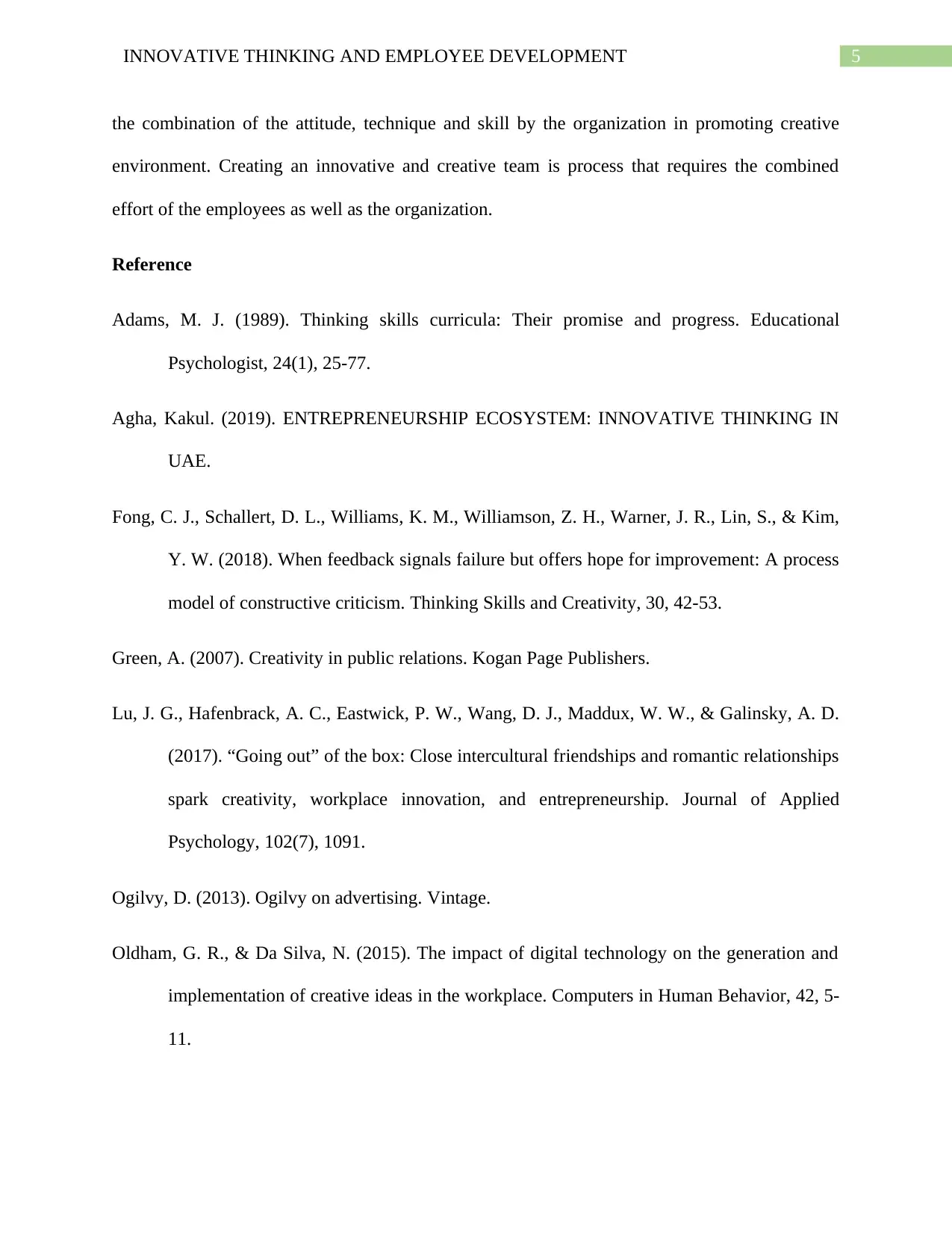
5INNOVATIVE THINKING AND EMPLOYEE DEVELOPMENT
the combination of the attitude, technique and skill by the organization in promoting creative
environment. Creating an innovative and creative team is process that requires the combined
effort of the employees as well as the organization.
Reference
Adams, M. J. (1989). Thinking skills curricula: Their promise and progress. Educational
Psychologist, 24(1), 25-77.
Agha, Kakul. (2019). ENTREPRENEURSHIP ECOSYSTEM: INNOVATIVE THINKING IN
UAE.
Fong, C. J., Schallert, D. L., Williams, K. M., Williamson, Z. H., Warner, J. R., Lin, S., & Kim,
Y. W. (2018). When feedback signals failure but offers hope for improvement: A process
model of constructive criticism. Thinking Skills and Creativity, 30, 42-53.
Green, A. (2007). Creativity in public relations. Kogan Page Publishers.
Lu, J. G., Hafenbrack, A. C., Eastwick, P. W., Wang, D. J., Maddux, W. W., & Galinsky, A. D.
(2017). “Going out” of the box: Close intercultural friendships and romantic relationships
spark creativity, workplace innovation, and entrepreneurship. Journal of Applied
Psychology, 102(7), 1091.
Ogilvy, D. (2013). Ogilvy on advertising. Vintage.
Oldham, G. R., & Da Silva, N. (2015). The impact of digital technology on the generation and
implementation of creative ideas in the workplace. Computers in Human Behavior, 42, 5-
11.
the combination of the attitude, technique and skill by the organization in promoting creative
environment. Creating an innovative and creative team is process that requires the combined
effort of the employees as well as the organization.
Reference
Adams, M. J. (1989). Thinking skills curricula: Their promise and progress. Educational
Psychologist, 24(1), 25-77.
Agha, Kakul. (2019). ENTREPRENEURSHIP ECOSYSTEM: INNOVATIVE THINKING IN
UAE.
Fong, C. J., Schallert, D. L., Williams, K. M., Williamson, Z. H., Warner, J. R., Lin, S., & Kim,
Y. W. (2018). When feedback signals failure but offers hope for improvement: A process
model of constructive criticism. Thinking Skills and Creativity, 30, 42-53.
Green, A. (2007). Creativity in public relations. Kogan Page Publishers.
Lu, J. G., Hafenbrack, A. C., Eastwick, P. W., Wang, D. J., Maddux, W. W., & Galinsky, A. D.
(2017). “Going out” of the box: Close intercultural friendships and romantic relationships
spark creativity, workplace innovation, and entrepreneurship. Journal of Applied
Psychology, 102(7), 1091.
Ogilvy, D. (2013). Ogilvy on advertising. Vintage.
Oldham, G. R., & Da Silva, N. (2015). The impact of digital technology on the generation and
implementation of creative ideas in the workplace. Computers in Human Behavior, 42, 5-
11.
⊘ This is a preview!⊘
Do you want full access?
Subscribe today to unlock all pages.

Trusted by 1+ million students worldwide
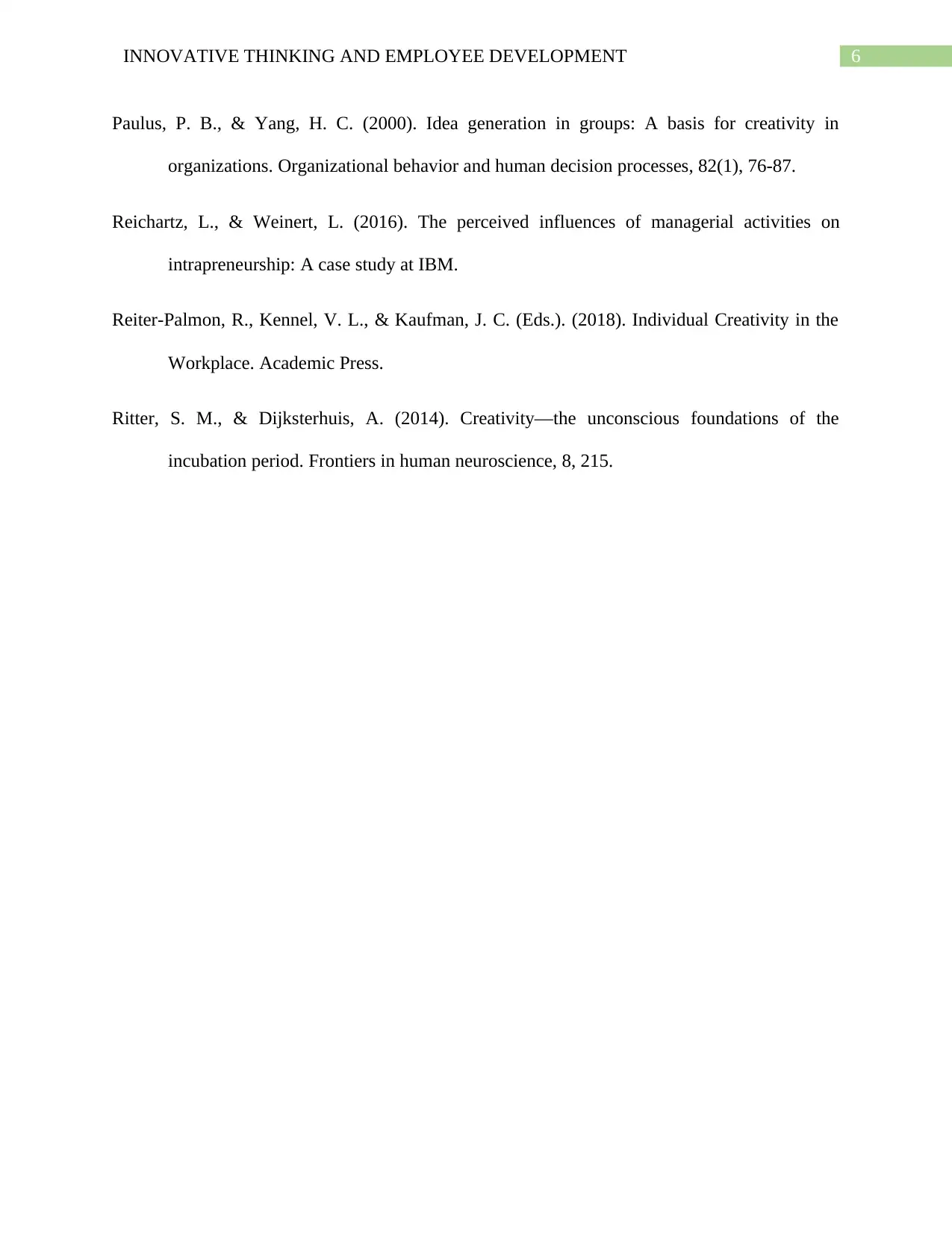
6INNOVATIVE THINKING AND EMPLOYEE DEVELOPMENT
Paulus, P. B., & Yang, H. C. (2000). Idea generation in groups: A basis for creativity in
organizations. Organizational behavior and human decision processes, 82(1), 76-87.
Reichartz, L., & Weinert, L. (2016). The perceived influences of managerial activities on
intrapreneurship: A case study at IBM.
Reiter-Palmon, R., Kennel, V. L., & Kaufman, J. C. (Eds.). (2018). Individual Creativity in the
Workplace. Academic Press.
Ritter, S. M., & Dijksterhuis, A. (2014). Creativity—the unconscious foundations of the
incubation period. Frontiers in human neuroscience, 8, 215.
Paulus, P. B., & Yang, H. C. (2000). Idea generation in groups: A basis for creativity in
organizations. Organizational behavior and human decision processes, 82(1), 76-87.
Reichartz, L., & Weinert, L. (2016). The perceived influences of managerial activities on
intrapreneurship: A case study at IBM.
Reiter-Palmon, R., Kennel, V. L., & Kaufman, J. C. (Eds.). (2018). Individual Creativity in the
Workplace. Academic Press.
Ritter, S. M., & Dijksterhuis, A. (2014). Creativity—the unconscious foundations of the
incubation period. Frontiers in human neuroscience, 8, 215.
1 out of 7
Related Documents
Your All-in-One AI-Powered Toolkit for Academic Success.
+13062052269
info@desklib.com
Available 24*7 on WhatsApp / Email
![[object Object]](/_next/static/media/star-bottom.7253800d.svg)
Unlock your academic potential
Copyright © 2020–2025 A2Z Services. All Rights Reserved. Developed and managed by ZUCOL.



